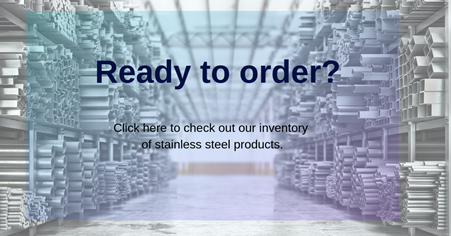.ashx?h=300&w=940&hash=357B3E0577C9475EB1306A911B929DAF)
Most notable for its resistance to both corrosion and staining, stainless steel is one of the most widely used metals in the world, found in products ranging from cookware to construction equipment.
When it comes to stainless steel sheet, knowing which grade to use for what application is important. For example, a grade’s ability to withstand various levels of corrosion is critically important—as not all grades of stainless steel are created equal.
All stainless steels are iron-based alloys containing at least 10.5% chromium. The rest of the makeup is defined by various alloying elements, which control the microstructure of the alloy. This is where the different grades come into play. Today there are roughly 200 different grades, all of which fall within one of the five families of stainless steel:
1. Austenitic
2. Ferritic
3. Martensitic
4. Duplex
5. Precipitation Hardening
This blog focuses on austenitic. Some says it is the most popular family, as it represents roughly 50% of the stainless steel used today. This is due in large part to the following characteristics of the metal:
Now let’s take a closer look at which grades are best suited for what applications—and why.
304
Where to use it: As the most widely used of all stainless steel sheet grades, 304 is most notably present in industrial applications and kitchen equipment.

Why: As a heat-resistant grade, 304 offers good corrosion resistance to many chemical corrodents, as well as industrial atmospheres. And with good formability, 304 can be readily welded by all common methods. An extra low carbon variation, called 304L, avoids harmful carbide precipitation due to welding. This variation offers the same corrosion resistance as 304, but with slightly lower mechanical properties.
316
Where to use it: Pumps, valves, textile and chemical equipment, pulp & paper and marine applications.
Why: This grade is more resistant to corrosion and pitting than 304 and offers higher strength at elevated temperatures. In addition, 316L is an extra low carbon variation that helps avoid carbide precipitation due to welding.
317L
Where to use it: Applications include FGD scrubbers, chemical and petrochemical processing equipment and pulp and paper equipment.
Why: Its chemistry gives it superior corrosion resistance in difficult environments, as well as higher creep, stress-to-rupture and tensile strength at elevated temperatures.
201
Where to use it: While originally developed for sub-zero temperature applications, it is also a fit for a range of structural applications at ambient temperatures. This includes truck trailers, railroad freight cars, coal handling and other transportation equipment where good corrosion resistance, strength and tolerance are necessary.
Why: This grade is formulated to have lower and more stable cost due to the substitution of lower cost manganese and nitrogen for a portion of the nickel found in the 300 series alloys. This grade possesses a desirable combination of economy, plus good mechanical and corrosion properties.

301
Where to use it: Mostly commonly used for sinks, as well as hose clamps and automobile moldings.
Why: Lower nickel and chrome than T-304, combined with slightly higher carbon content gives T-301 increased cold work-hardening range. This permits higher tensile strength to be achieved. The grade is more susceptible to carbide precipitation during welding. This restricts its use in some applications in favor of T-304 or 304L.
309
Where to use it: In high temperature applications.
Why: With high scale resistance and corrosion resistance superior to 304, 309 is excellent in resisting sulfite liquids, nitric acid, nitric-sulfuric mixtures, acetic, citric and lactic acids.
321
Where to use it: In applications that require immunity to most organic chemicals, dyestuffs and many inorganic chemicals.
Why: This grade is stabilized with titanium for weldments subject to severe corrosion. With no carbide precipitation, it possesses excellent resistance to a variety of corrosive media.
254SMO
Where to use it: Ideally suited for such high chloride environments as brackish water, seawater, pulp mill bleach plants and other high chloride process streams.
Why: This grade is designed for maximum resistance to pitting and crevice corrosion and with high levels of chromium, molybdenum and nitrogen.
Nitronic 30
Where it is used: Applications requiring a good level of aqueous corrosion resistance, combined with good resistance to abrasive and metal-to-metal wear.
Why: It is nitrogen-strengthened.


